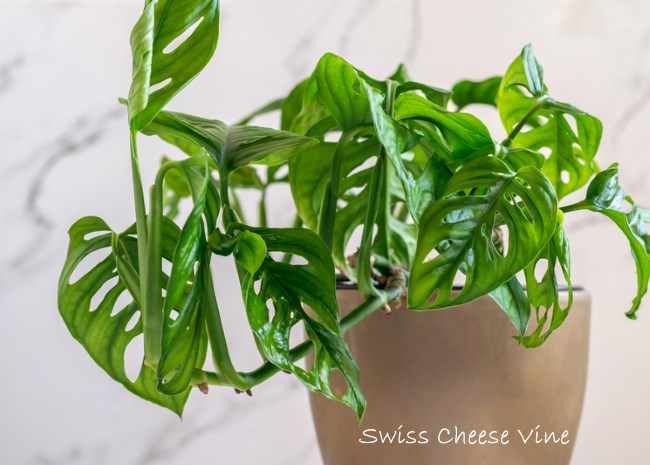Jan 25, Monstera Adansonii Care: Grow Swiss Cheese Vine Houseplant
Monstera adansonii care is easy, once you get to know this tropical vine. Find out how to water, when to repot, how much light it wants year-round, and keep your Swiss Cheese Vine thriving indoors.
 It’s easy to see where the “Swiss cheese” name comes from. Photo credit: ©Galina Burgart
It’s easy to see where the “Swiss cheese” name comes from. Photo credit: ©Galina BurgartGet to Know Monstera Adansonii
Do you love the holey leaves of exotic Monstera deliciosa, but don’t have the space?
Monstera adansonii is every bit as captivating as the jungle giant without taking over a room. Young plants make a charming table accent. As it grows, you’ll want to set it high on a plant stand or shelf and allow the vines to cascade. Or set it in a hanging planter and admire those “Swiss cheese” leaves at eye-level. Want a climber? Provide a trellis or moss stick and watch Monstera adansonii scale to new heights. This tropical vine allows a lot of ways to display it.
Monstera Adansonii Care Problems, Solutions and Answers
Brown leaf tips are caused by dry air or dry soil. Give this tropical native the moisture it craves by watering thoroughly and boosting humidity around it. See “Water” and “Humidity” tips below.
Yellow leaves? You over-watered. Use a pot with drainage holes and allow potting mix to dry slightly before watering.
Leaves that grow without holes are a sign your Swiss Cheese Vine isn’t getting enough light. Don’t treat Monsteras like Philodendrons, that will tolerate shadier places in your home. Move your houseplant near a window, but out of hot, direct sunlight. If you don’t have a sunny spot for it, use a grow light.
Something bugging your houseplant? Although not common on Monstera spp., spider mites are attracted to houseplants, especially during the winter months when indoor humidity can drop drastically. These destructive pests are so tiny, you’ll likely only notice the fine webbing between stems and leaves. Gently wash off the leaves and vines with soapy water. Also watch for mealybugs that tend to cluster along the stems near the base of leaves. Isolate any infested houseplant and treat it right away.
Monstera Adansonii Care
Origin: Central and South America
Height: Vines will climb or trail up to 8 ft (2.4 m)
Light: Bright, indirect light is ideal. Keep Monsteras out of direct sunlight, which will burn its leaves, causing dry, brown spots. If new leaves on mature plants are smaller or grow without holes, give it brighter light. It responds well to a grow light. Keep the light fixture about 8 to 10 inches (20 to 24 cm) above the plant for 10 hours a day.
Water: Use a pot with drainage holes to prevent soggy potting mix. Water thoroughly and allow the top inch of soil to dry out before watering again. Keep soil barely moist in winter. Yellow leaves are usually a sign of overwatering.
Humidity: Monstera adansonii care includes higher-than-average humidity. Boosting humidity is easy with a cool-mist room humidifier. It’s a good idea to use a humidity gauge rather than guess. Aim for a minimum of 50% relative humidity near your houseplant. This rainforest native will tolerate a drier home, but you may see brown leaf tips on it.
Temperature: Monstera adansonii likes average room temps (65-75°F/18-24°C).
Soil: Mix 1 part peat moss-based mix and 1 part sand or perlite for faster drainage.
Fertilizer: Feed every 2 weeks spring through fall with a balanced water-soluble fertilizer. You can stop feeding in winter, when growth is slow.
Propagation: Take growing tip cuttings of a mature plant and insert them into moist peat moss based potting mix. Keep cuttings warm (around 70°F/21°C) and in indirect sunlight or artificial light. Spring is the best time to propagate because Monstera adansonii is beginning its most vigorous time of growth.
Published at Tue, 25 Jan 2022 13:26:31 -0800